Lea Wait's Blog, page 48
January 1, 2024
Resolutions (more or less)
Kaitlyn Dunnett/Kathy Lynn Emerson here. 2023 was an interesting year. Nothing monumental happened chez Emerson, but one way or another, I did a lot of organizing. The blog I posted last May about the hassles an author’s estate can cause his or her heirs prompted me to do a lot of that. It’s an endless task, but I think I made a good start. I’ve always been pretty good at making lists and inventories.

My first resolution for 2024 is to keep everything I organized in 2023 up to date in 2024. I’ve learned the hard way that it’s soooo much easier to do that if, for example, I add new items to lists as soon as they’re created. Putting off that task just means ending up with an accumulation of “to be added” items and that leads to procrastination. Sometimes, the job never gets done.

Resolution number two is also a “maintenance” item. For the first time in more years than I want to admit to, I saw a number under 200 on my bathroom scale. I didn’t diet in 2023, but I did have a couple of stretches where certain items were forbidden for nibbling. I have no willpower, so that meant “not anywhere in the house” or they’d be eaten. A bag of Dove dark chocolate promises? Gone in a week. A family-size bag of potato chips? Gone in two days, max. To keep my weight down all I have to do is not buy chocolate, ice cream, pretzels, potato chips, whoopie pies, brownies, cake, pie . . . you get the idea. That still leaves popcorn, nuts, apples, saltines, graham crackers, and cereal for snacks—better than nothing but never as good as chocolate. Sigh.

Beyond those resolutions for 2024, I pretty much plan to keep on doing what I have been doing—revising older books to reissue in e-book and print on demand formats. My only deadlines will be the ones I set for myself, which means I have no excuse not to work in some daily exercise sessions and regular opportunities to get out of the house. How will I spend the rest of my time? I’ll be reading other people’s books, of course.
I’d love to have readers chime in with their plans for the new year, whether they are resolutions or just aspirations. Please share your thoughts in the comments.

Kathy Lynn Emerson/Kaitlyn Dunnett has had sixty-four books traditionally published and has self published others. She won the Agatha Award and was an Anthony and Macavity finalist for best mystery nonfiction of 2008 for How to Write Killer Historical Mysteries and was an Agatha Award finalist in 2015 in the best mystery short story category. In 2023 she won the Lea Wait Award for “excellence and achievement” from the Maine Writers and Publishers Alliance. She was the Malice Domestic Guest of Honor in 2014. She is currently working on creating new omnibus e-book editions of her backlist titles. Her website is www.KathyLynnEmerson.com.
December 29, 2023
Weekend Update: December 30-31, 2023
Next week at Maine Crime Writers there will be posts by Kaitlyn Dunnett/Kathy Lynn Emerson (Tuesday), Kate Flora (Thursday) and Brenda Buchanan (Friday).

In the news department, here’s what’s happening with some of us who blog regularly at Maine Crime Writers:
An invitation to readers of this blog: Do you have news relating to Maine, Crime, or Writing? We’d love to hear from you. Just comment below to share.
And a reminder: If your library, school, or organization is looking for a speaker, we are often available to talk about the writing process, research, where we get our ideas, and other mysteries of the business, along with the very popular “Making a Mystery” with audience participation, and “Casting Call: How We Staff Our Mysteries.” We also do programs on Zoom. Contact Kate Flora
The Way You Do the Thing You Do

My first reader – Cub
Happy New Year to all. Hard to believe we are saying goodbye to 2023 and looking forward to the adventures that 2024 holds in store. This is my favorite time of the year. I admit, I’m a proponent of Marie Kondo. I love clearing out the old to make way for the new. Same goes for goal setting and planning.
When you’re a writer, goal setting includes an element of hope and luck. It takes a while to write a book. The time varies by writer, and by book. A new book with new characters can take up to a year. A deep edit of an existing manuscript, three to six months. This year, I’m planning two new books and two re-releases. Ambitious. Maybe. But I have a plan.
I was one of several authors invited to a Zoom book club meeting. After the book discussions, the moderator opened the floor to general questions. Rather than further discussion of the books, the questions veered to how we write. Who knew there would be so much interest in how we make the sausage?
I admit I’ve developed an arsenal of writer’s aids over the years. None are a substitute for research and words on the page, and none make use of the buzzword of 2023 – AI. Nope, I’m an old-fashioned writer. Curiosity, plot, plan, write, edit, despair, consider dumping the lot, revise, polish, joy. And I’ve a writer’s aid for each segment.
Every story starts with a “what if” question. There’s no substitute for that. For No Return, the first Maine Mystery, I wanted to explore Maine’s porous border and the effect on Northwoods locals. Not very exciting, but toss in a long vacant guest lodge, a body in a pottery studio, a rekindled romance, and the economic engine of tourism, and bits and pieces fall into place. So, how to take that from idea to page?
Plot comes first. For this I use Plottr. There are a million ways to plot a book. Among them, the three-act structure, the four-act structure, Save the Cat, and my favorite, Story Engines. Plug one into the program, and a visual timeline appears. The program is customizable, but I find one sentence at each plot point is enough to tell me if the story has what it takes to hold my interest, and ultimately, a reader’s interest.
Once the plot is in place, it moves to Scrivener. This is where the writing takes place. It’s another visual program. I use it to write each scene and chapter on separate “cards” and keep track of characters, settings, and plot points. I can move the scene cards around at will as the needs of the story change and grow. Best of all, it interfaces with Word and allows me to keep track of multiple versions during and after edits. Of course, Cub is very helpful at this stage of the process.

Piper – my editor and harshest critic
Editing is as close to AI as I get. My weapon of choice is ProWritingAid and I use it for grammar and comma (the bane of my writing existence) assistance. It’s invaluable at identifying misused words and spelling errors. Some of my errors are laugh out loud funny and the program has saved me from a case of chronic red-face. I save my edited work to Scrivener and then export it to Word who reads to me. It’s amazing what the ear hears that the eyes miss. Then it’s off to beta readers and ready for prime time. Piper has the final word on whether it’s ready to go. Clearly, she thought this story needed more work.
That’s my recipe for sausage. Remarkable how similar it is to other authors. Much different to the early days.
December 27, 2023
CHRISTMAS BOOKS – A collection of holiday tales
Charlene D’Avanzo: When many people think of Christmas they dream of snow covered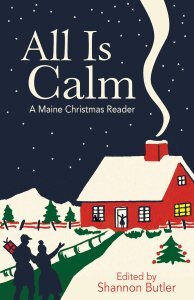 pine trees and a small cabin warmed by the wood fire on a cold December day. Since Maine was founded, people have written stories about the joys of Christmas in the state. In times of hardship and wealth, Mainers put the value of Christmas in time shared with family and friends, connections with the natural world, rich traditions, and warm wood stoves. In a collection featuring essays, stories, and poetry, All Is Calm looks at the lives of Mainers during the holidays from the mid-1800s, to the Great Depression, to modern day. Spanning nearly 200 years, these stories show that while Christmas traditions and trends may be changing, the warmth, gratitude, and humility of the Maine spirit is evergreen.
pine trees and a small cabin warmed by the wood fire on a cold December day. Since Maine was founded, people have written stories about the joys of Christmas in the state. In times of hardship and wealth, Mainers put the value of Christmas in time shared with family and friends, connections with the natural world, rich traditions, and warm wood stoves. In a collection featuring essays, stories, and poetry, All Is Calm looks at the lives of Mainers during the holidays from the mid-1800s, to the Great Depression, to modern day. Spanning nearly 200 years, these stories show that while Christmas traditions and trends may be changing, the warmth, gratitude, and humility of the Maine spirit is evergreen.
Why Christmas Trees Aren’t Perfect – Long, long ago, in a land far away, lived a perfect little tree named Small Pine. Small Pine hoped to maintain its perfect form and be selected by the Queen as her Christmas tree. But as the warm-hearted little tree gave shelter to birds, rabbits, and deer in the forest, its branches became damaged. Fortunately, the Queen had a different idea of perfection…
Young readers will want to read and reread the story of how Small Pine’s love and charity for its friends helps make it the most “perfect” Christmas Tree of all. This beautifully illustrated story of a warm-hearted Christmas tale will surely become one of the most beloved classics of future generations. Schneider’s storytelling will enthrall children and adults alike. A Children’s Christmas Classic for Over 20 Years!
 A Christmas by the Sea – Melody Carlson. When Wendy Harper inherits her family’s beachside cottage in Seaside, Maine, she can finally pay off the debts that mounted since her husband died. But the neglected property needs renovation before it can be sold, so Wendy and her young son Jackson move in to fix the place up to sell. Soon the town makes it difficult for Wendy to resists their charms.
A Christmas by the Sea – Melody Carlson. When Wendy Harper inherits her family’s beachside cottage in Seaside, Maine, she can finally pay off the debts that mounted since her husband died. But the neglected property needs renovation before it can be sold, so Wendy and her young son Jackson move in to fix the place up to sell. Soon the town makes it difficult for Wendy to resists their charms.
Slashing Through the Snow: A Christmas Tree Farm Mystery Reindeer Games Christmas Tree Farm is going into the B&B business, and Holly White is looking forward to her new role as innkeeper. Even better, Mistletoe, Maine’s sheriff, Evan Gray, has deputized his little sister Libby to help Holly wrap presents for Mistletoe’s toy drive. But a cold wind ruffles the cheery holiday decorations when a new guest checks in: Karen, a vicious B&B critic, who could make or break the new inn. And the short December days turn even darker when Evan and Libby find Karen’s dead body in the gift-wrapped toy donation box. Filled with quirky local character this is a fun murder-mystery.
The Coast Of Maine – Carl Helman “A stunning keepsake album for one of America’s favorite vacation destinations, with panoramic-style photographs of coastal Maine’s grand mountains, pristine woods, and dramatic shoreline.” The photographs capture sandy beaches and tidepools, tree-covered mountains, secluded harbors, historic lighthouses, and lobster boats along the coast.
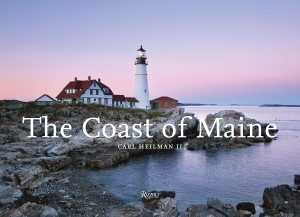
December 26, 2023
When Life Gives You Pumpkins
Today Maine Crime Writers welcome back Sylvie Kurtz, our New Hampshire neighbor. Last year, Sylvie’s guest post dealt with two Yuletide novels she set in the fictional town of Brighton, New Hampshire, Christmas in Brighton and Christmas by Candlelight. She is also the author of A Little Christmas Magic. Now she’s gone back to Brighton to celebrate a different holiday, and ventured into a new length and a new genre, as well. Here she is to tell us how all that came about.
When Life Gives You Pumpkins . . .
When news of my mother’s death came, I was in the middle of writing a light, summery novel, featuring a strawberry festival and a baking contest. Then I found I couldn’t write. At. All. I just couldn’t find the joy needed to write a snow globe-type of novel. For six months, I tried to go back to the story. Nothing flowed. And I was getting frustrated.
I needed something to disrupt the stuckness.
 When I came across Natasha Sass’s cozy novella writing course (https://the-indie-writers-workshop.teachable.com/p/halloween-cozy-novella-workshop), something urged me to try it. I love reading cozies but never planned on writing one. I’m not sure why. A novella is short, so if it didn’t work to unstick me, I hadn’t invested too much into it. And I’d wanted to learn to write shorter for a while.
When I came across Natasha Sass’s cozy novella writing course (https://the-indie-writers-workshop.teachable.com/p/halloween-cozy-novella-workshop), something urged me to try it. I love reading cozies but never planned on writing one. I’m not sure why. A novella is short, so if it didn’t work to unstick me, I hadn’t invested too much into it. And I’d wanted to learn to write shorter for a while.
So, two stones, one course.
We all write in a different way. Some of us need to know every detail before we start. Others feel if they know the story before they write, there’s no point in writing it. I’ve always fallen somewhere in between. I need a few road signs but still want the story to surprise me. So having a novella roadmap was helpful.
Before I knew it, I had a sleuth, a sidekick and a situation that fit right into my fictional Brighton world. The skeletons and spiders and spooky atmosphere were just the thing to get me unstuck. The darker mood didn’t feel disrespectful. The words didn’t exactly flow, but there were words on the page. The more I wrote, the easier writing got. By the end, I was having fun writing again.
I’d accomplished both of my goals: I got unstuck and I wrote something shorter than my usual 80,000+ words. I enjoyed writing the cozy so much, Ellie and Page might just see another sleuthing adventure.
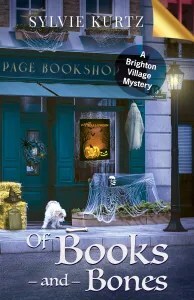
Of Books and Bones (https://sylviekurtz.com/of-books-and-bones) is the result of my unsticking experiment.
Brighton, New Hampshire, is known for its festivals and fun . . . not for murder.
Ellie Hamlin is looking forward to early retirement and travel with her chief-of-police husband. Then her world turns upside down when an expansion at her sister-in-law, Page’s, bookstore uncovers bones.
Ellie’s daughter becomes falsely implicated in the murder, and her husband has to leave the investigating to someone else. With her daughter’s freedom on the line, Ellie can’t stand back. And Page, who’s always wanted to sleuth, insists on tagging along.
With Ellie and Page’s investigation, the number of suspects rise…and so does someone’s fear of discovery.
Then a terrible accident happens, redoubling their need to find the killer.
Amid a slew of tricks and treats and things that go bump in the night, can Ellie and Page solve the crime and bring a murderer to justice before one of them becomes the next victim?
Welcome to Brighton, a picturesque New Hampshire small town steeped in family, food, friendships and festivals. And now its first cozy mystery.

The lesson for me in all of this is that an old writer can still learn new tricks, and trying something new can widen the horizon.
Merry post-Christmas and Happy New Year!

Sylvie writes stories that celebrate family, friends and food. She believes organic dark chocolate is an essential nutrient, likes to knit with soft wool, and justifies watching movies that require a box of tissues by knitting baby blankets. She has written 25 novels in various genres. Visit www.sylviekurtz.com for more information.
The Holidays
“It was the best of times, it was the worst of times, it was the age of wisdom, it was the age of foolishness, it was the epoch of belief, it was the epoch of incredulity, it was the season of light, it was the season of darkness, it was the spring of hope, it was the winter of despair.”
― Charles Dickens, A Tale of Two Cities
Charles Dickens is writing about the French Revolution, but he might as well have been writing about the Industrial Revolution that was his time period, or maybe even the world of today, if he was an oracle in line with George Orwell.
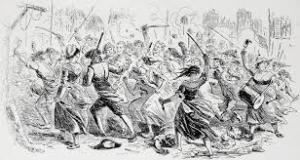
All three of these eras are ages of paradox. The rich live safe and leisurely existences far removed from the realities of most of the population. The French Revolution, Industrial Age, and Now are times of extreme wealth and of extreme poverty, a polarization of the whole truth, with a middle class plunked down on the lower side of the stratosphere.
And this best of times and worst of times is also representative of the paradox of the holidays. Whether you celebrate Bodhi, Our Lady of Guadalupe, Hannukah, Yule, Christmas, Kwanzaa, or something else, it can be a wildly chaotic time. For those with money, family, friends, and love—it can be a wonderful celebration of life. For those struggling to pay the bills, it can be an enormous financial weight similar to cement shoes in a river. Many people feel alone and isolated as the world revels around them.
The holidays are a time where it is stressed that is important to ask for help when help is needed. Whether it be money, sadness, remorse—it is essential to realize that you are not alone. And this means that it is crucial that those on the other side of the paradox, those with the means and the relationships of love, are ready to extend a hand.

The holidays should not be the worst of times for anybody, not with so many of us living the best of times. None of us should live alone on a mountain top, nor need the visit of three spirits to wake us to the true meaning of the holidays. Nobody should feel the isolation of the Grinch nor the miserliness of a Scrooge.


Let us make this the best of times and the season of light. We are all one people. Happy Holidays.
Write on.
Matt Cost was a history major at Trinity College. He owned a mystery bookstore, a video store, and a gym, before serving a ten-year sentence as a junior high school teacher. In 2014 he was released and began writing. And that’s what he does. He writes histories and mysteries.
Cost has published five books in the Mainely Mystery series, with the fifth, Mainely Wicked, just released in August of 2023. He has also published four books in the Clay Wolfe Trap series, with the fifth, Pirate Trap, due out in March of 2024.
For historical novels, Cost has published At Every Hazard and its sequel, Love in a Time of Hate, as well as I am Cuba. In April of 2023, Cost combined his love of histories and mysteries into a historical PI mystery set in 1923 Brooklyn, Velma Gone Awry. City Gone Askew will follow in July of 2024.
Cost now lives in Brunswick, Maine, with his wife, Harper. There are four grown children: Brittany, Pearson, Miranda, and Ryan. A chocolate Lab and a basset hound round out the mix. He now spends his days at the computer, writing.
December 22, 2023
Weekend Update: December 23-24, 2023
 Next week at Maine Crime Writers there will be posts by Matt Cost (Tuesday), special guest Sylvie Kurtz (Wednesday), Charlene D’Avanzo (Thursday) and Kait Carson (Friday). Happy Holidays Everyone!
Next week at Maine Crime Writers there will be posts by Matt Cost (Tuesday), special guest Sylvie Kurtz (Wednesday), Charlene D’Avanzo (Thursday) and Kait Carson (Friday). Happy Holidays Everyone!
In the news department, here’s what’s happening with some of us who blog regularly at Maine Crime Writers:
John Clark’s YA Christmas story is up at YAOTL. http://yaoutsidethelines.blogspot.com/2023/12/well-figure-it-out.html
An invitation to readers of this blog: Do you have news relating to Maine, Crime, or Writing? We’d love to hear from you. Just comment below to share.
And a reminder: If your library, school, or organization is looking for a speaker, we are often available to talk about the writing process, research, where we get our ideas, and other mysteries of the business, along with the very popular “Making a Mystery” with audience participation, and “Casting Call: How We Staff Our Mysteries.” We also do programs on Zoom. Contact Kate Flora
December 21, 2023
Could November Be the Cruelest Month?
I know a lot of people hate the month of November, especially here in the Northeast. It is almost always gray, dark, wet and windy, often without the layer of pristine snow that covers the sins of the careless yard person: unraked leaves, mole holes, bare dead patches of lawn. The ice on the pond skims, but doesn’t harden enough to hold up a duck, and the turkeys are so stunned they can barely fly their clumsy selves up to the lowest branches when startled. It’s a liminal time, neither here nor there.
and the turkeys are so stunned they can barely fly their clumsy selves up to the lowest branches when startled. It’s a liminal time, neither here nor there.
The darkness, the darkness. The earlier and earlier sunsets, right through early December, then the winter solstice, the shortest and darkest day of the year. The deer are sneaking around, trying not to get shot. The squirrels are frantically stockpiling acorns to survive whatever January brings. Teachers hold on by their fingernails for the break the holidays provide.
I love November, though I didn’t always. This is why: more soups and stews, long braises of cheap cuts of meat, more baking. Wool shirts and fleece over Hawaiian shirts and shorts. Porters and stouts over lagers and ales. Boots over flipflops. Pinot noir and cabernet over rosé and pet nat. Sunrises and sunsets of peach, rose, and gold.
I have visited San Diego. I cannot imagine living in a mono-meteorological world, where the sun shines every day and the temperatures don’t vary much. Give me a warmish rainy day like today followed by nose-hair freezing cold. Followed by whatever happens next. Cold mist, fine as wind-blown salt scours your cheeks. Surprise me. Besides, if we didn’t have the weather, what would we taciturn Mainers have to talk about with each other?
The threshold of winter is the tease of the past season, the promise of the future. My father died in November, my mother not long after. You would think that would spoil the month for me, but instead it reminds me to engage my memories.
Two years after they died—within a month of each other—I found myself teary in public, as if grieving them for the first time. It was a Christmas concert, choral music, in a cathedral in downtown Portland.  The whole first year after they died, I was closing up their estate, so still involved with them somehow. They were still there for me, if only in the paperwork and the bequests.
The whole first year after they died, I was closing up their estate, so still involved with them somehow. They were still there for me, if only in the paperwork and the bequests.
Now I have these memories: my mother loved the Canadian Brass; their Christmas music was a staple of our home on the season. My father left work and drove to college in November of my freshman year to pick me up, after a clumsy judo instructor dislocated my right knee. He worried out loud that, like a friend who’d had a motorcycle accident, I might be crippled for life.
This is the season when we all have to pay more attention to the externals—the wind, the sleet, the dark. Snow is the least of our worries, when we have black ice. But we know how to be safe in those things. What we don’t always know is how to navigate safely the memories that hurt and heal us. November gives us space to do that, if we’re willing, to turn inward, be thoughtful and slow ourselves down. In that sense, it cannot be the cruelest month. If, indeed, there is one.
December 20, 2023
Gifting. No Wrapping Necessary.
Sandra Neily here with a gift from Maine Crime Writers’ reader Mary Ann and my story of the best gift ever. (My best gift ever.)
 Raven gives the birds her gift, keeping squirrels off the feeder.
Raven gives the birds her gift, keeping squirrels off the feeder.
The Affordable, but Really Good Eats Quest. 
Last month, (fed up with not-worth-it but expensive food), I asked readers this question. “How might we eat out one or two times a month and spend less than $40-$45 per meal? Hopefully less than $35. Hopefully, around $75 per month for two evenings out. The food has to be really, really good food.”
Mary Ann (using the formula I suggested), generously sent this review for us to share. Thanks, Mary Ann! (I plan to head there for the flatbread pizza and coleslaw and of course, a long browse at Shermans Books.)
T rackside Station, Rockland, Maine (Reviewed by Mary Ann)
rackside Station, Rockland, Maine (Reviewed by Mary Ann)
The Good: Trackside combines the best of pub food with touches of fine dining. On the menu are such appetizers as pretzel bites and chicken wings, perfect to go with drinks at the bar. On that same menu you can also find Lobster Scampi, complete with herbs and white wine for date night. The daily specials include favorites such as poutine(house-made poutine gravy with One of my favorite meals to have is the flatbread “pizzas” which rotate through the specials menu. I still remember that steak and cheese with homemade aioli sauce.
Needs Work or Don’t Order: I can honestly say that I have had few disappointments with the food. If you like your fries crisp, the hand cut fries may not be for you. I’d suggest one of the best coleslaws I’ve had instead.
Good to Know: It’s located in an old railroad station and I am all about ambiance when I go out to eat. High ceilings and everywhere you look the décor includes signs that point the way to the baggage claim and the streets. Friday and Saturday nights include live music! A regular rotation of solo and duo acts create a lively atmosphere perfect for the weekend!
The Approximate Bill: My husband and I dine here almost every weekend. It’s our end of the week treat. Entrees run between $15-$20, with seafood being a little higher at around $25. We order soft drinks and our bill runs about $45 to $50 without the generous tip that I leave. If you stop and take in the entertainment, this is a reasonable price to pay for an evening out.
******************************


The Best Gift
This time of year, rather than buy gifts (granddaughters are an exception) I make cookie gifts and think about gifts I’ve enjoyed receiving as well as giving. This very short story (reprinted from a previous post) is about the Best Gift …ever.
The Backstory: Bread Loaf Writers Conference challenge:
We’re in the middle of a field looking at Vermont’s impossibly green hills, sitting where, since 1926, generations of writers have come to learn the craft. Our instructor tells us she wants a short, short story about something that deeply affected us, told in the point of view of someone else. She says our work merely skirts human emotions and we must go deeper. “Try letting yourself out through another’s eyes.”
Then she quotes Robert Frost who was an early and frequent teacher, presenter, and mentor at the Bread Loaf Writers’ Conference. “No tears in the writer, no tears in the reader. No surprise in the writer, no surprise in the reader.”
I called up my daughter’s voice and channeled my last real family Christmas—through her eyes. Months later, I showed her the story and she said, “You nailed it, Mum.” Better praise than any critic could give.
WHEN THE HOLIDAY IS OVER BEFORE IT’S BEGUN by Sandra Neily
When I pull into the driveway, I count five cars parked in the first winter snow next to the stone wall under the pines. The camp’s green walls are holiday card perfect with wispy flakes on sills and roof. I see that Mum has, as always, tucked red bows into pine branches hanging from window boxes. Red, green and white. So it’s going to be a traditional Christmas is it?
 Wood smoke blows low across the deck, pushed by a bad-weather-wind toward the lake where ice is rattling in small rafts of cubes. One morning we will wake and find the cove glued into ice- hard silence. It could happen that fast. Lots can happen that fast. Overnight.
Wood smoke blows low across the deck, pushed by a bad-weather-wind toward the lake where ice is rattling in small rafts of cubes. One morning we will wake and find the cove glued into ice- hard silence. It could happen that fast. Lots can happen that fast. Overnight.
No tracks; everyone’s been inside for hours unwrapping presents, eating Mum’s coffee cake, probably made with berries she froze last summer anticipating weekends of blue-flecked muffins and family Scrabble games. Zachary, the youngest nephew, is probably walled inside a castle of toys and gifts and well on his way to an early afternoon breakdown from getting too much of what he wants.
And what do I want? I want this to be over. I want to crawl into the bed I’ve had since I was two, pull Pooh Bear under the covers with me, and when I wake up, find my father on the roof, shoveling great clots of snow into a mound I will make into a snow cave. Before I can get up the stairs to that Christmas wish, I have to open the door—and what?
Will we be pretending today? After fifteen years of camp family holidays, that seems likely.
They hear the front door and spill into the front room to hug me. The chaos is familiar and washes over me like a bright wave of welcome water.
“What took you so long?”
“How were the roads? Icy?”
“We saved all our Elizabeth presents to have Christmas part two with you!”
“Look at all the dragons I got. They’re on the floor breathing fire on each other. Some just got killed.”
I look around for Mum The living room floor is awash in paper, ribbon, half chewed dog toys and plates of cake crumbs. There’s a monument of a tree in the living room, easily over 10 feet tall and it looks like every light and ornament is out of storage and propped on its limbs. My aunt is setting the long dining room table with the traditional red cloth, and my grandmother is attempting to settle Zachary with a story.
The walls of pictures are rearranged. My Dad is missing except for early baby pictures of us together. There are no pictures of my parents together. There’s a lighter space on the wall where my dad’s tarpon used to hang over the bar counter. I wonder how long it will take for the wall’s fish outline to disappear into the smoke darkened panels beside it.
I climb up to drop my bag in my small room at the top of the stairs. Mum has put the Santa music box on my bedside table. I wind it up to hear its familiar holiday song. “You better not cry …” in tinkling tones. As Santa revolves, his serious eyes meet mine for a few seconds in each turn. “You better not cry.” This is the first time I’ve been home since I lost my family. Nothing has changed in my room; pictures of us together sit on my bureau and bookcase. Sitting on the bed I can sort out the smells of roasting turkey and simmering garlic from the spicier ones of pumpkin pie.
Mum must be in the kitchen, but then suddenly she is there at my door. She might look the same to her family. I can see the effort she’s made to be dry-eyed and energetic, but I think she looks too pale, even for winter. She’s made no effort to re-color the grey wisps at her temples, and under the apron she’s just thrown on an old T-shirt that’s inside out.
She hugs me and sits on the bed. “If you don’t want to, we don’t have to do this anymore,” she says. “It was too late to change it this year.”
I nod. “This will be our last Christmas like this,” I say firmly. “It’s over.”
“Let’s make a new tradition when we get this sorted out,” she sighs. “Everyone’s waiting for us to open your presents. Let’s go down.”
“Mum.” I lean on her. “I love you.”
“I love you too, Elizabeth. You are the best present that I ever got.”
And since she has said that to me with tears in her eyes on every birthday and every Christmas, just as she’s saying it today, I feel stronger. We hold hands and climb down the stairs.
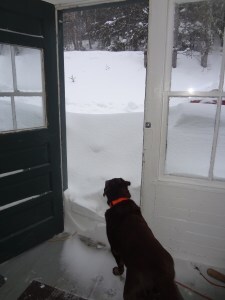 Wishing you all a real Maine blizzard instead of a December flood.
Wishing you all a real Maine blizzard instead of a December flood.
Sandy’s debut novel, “Deadly Trespass, A Mystery in Maine” won a national Mystery Writers of America award, was a finalist in the Women’s Fiction Writers Association “Rising Star” contest, and was a finalist for a Maine Literary Award. The second Mystery in Maine, “Deadly Turn,” was published in 2021. Her third “Deadly” is due out next year. Find her novels at all Shermans Books (Maine) and on Amazon. 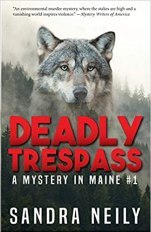
Kiki Saves The Day – A Christmas Story
Kate Flora: As promised, here’s this year’s Christmas story:
Kiki Saves The Day: A Christmas Story
 I should introduce myself properly. My name is Kiki. I have blonde curly hair and shiny dark eyes. I am middle aged. I love exercise, primarily walking. I weigh a trim eighteen pounds, have a fondness for treats, and can dance on my hind legs to entertain my human.
I should introduce myself properly. My name is Kiki. I have blonde curly hair and shiny dark eyes. I am middle aged. I love exercise, primarily walking. I weigh a trim eighteen pounds, have a fondness for treats, and can dance on my hind legs to entertain my human.
Ah, yes. My human. I have primary responsibility for a human named Andy. More properly Andrew, but no one calls him that. Andy is in what humans call old age, meaning he is more than fifteen in dog years. Andy isn’t exactly lazy but without me, he wouldn’t get much exercise. I do my best to take care of him, which is sometimes difficult. Andy likes to sit is his chair and read. My challenge is to get him to leave his work and come outside.
Once he’s outside, he’s usually glad he’s there. Andy isn’t antisocial, he’s shy. We have good neighbors, though, who understand about his shyness and find ways to engage with him anyway. There’s Alice, across the street, who worries about his nutrition and is always bringing him—us—food. We’re lucky that Alice is a good cook, because without her visits and the casseroles she brings, Andy would forget to eat. He’s what I’ve heard called “an absentminded professor.”
Alice has a dog that looks after her, too. A lumbering, joyous black Lab named Otto. People might scoff at this, since we’re animals, but I consider Otto to be my best friend. While Alice visits with Andy and catches him up on what’s happening in the neighborhood, Otto and I race around the yard. As a great example of why Otto is my friend, he is very considerate of the fact that he’s about three times my size, so he slows his pace to accommodate my short legs.
I guess I can say this: I really love Otto. He’s so kind and caring. He’s also smart, which his lumbering gait and exuberance don’t reveal. He can find things that people have lost. He’s good at comforting children who’ve fallen or who are shy and scared. He’s very protective of Alice and will get between her and anyone or anything he perceives as a threat. He can also catch a ball in midair and will carry his favorite stick for a mile if he and Alice are walking.
I watch the news with Andy every night, curled up on the sofa on my special blanket, and I often wish that humans could be as good as Otto instead of hurting each other.
We have other neighbors, too. On one side of our house we have Mike and Sally and their twins, Leo and Cleo. The twins are just learning to walk and talk and are very funny to watch. Sometimes Otto will walk with them so they have something to grab onto if they think they might fall. I wouldn’t be good at that. I am good at dancing to make them laugh and believe me, a toddler’s laugh is a marvelous thing. Even Andy, who is shy around children, loves the twins. Leo, who talks more, calls him “Dandy” which makes him laugh.
Lest you think our neighborhood is all sweetness and light, there’s our neighbor on the other side, Bad Billy. I didn’t name him that, though I like the alliteration. Andy did. He’s usually not judgmental but it would be hard for anyone not to judge Bad Billy. He’s so disagreeable it’s as though he has a smelly green cloud around him, like a poison gas or something.
Right. You are thinking: How would a dog know about poison gas, right? Well, remember we dogs have excellent senses of smell. Far better than humans. So of course I know Bad Billy doesn’t bathe often and consequently stinks. The use of the term “poison gas” though, comes from Andy. He lives so much in his head he pretty much ignores the world around him unless forced into being observant by neighbors like Alice or Mike and Sally. Once Andy used the word “miasma” about Billy. Alice asked what it meant and Andy said the thing about the poison gas.
Anyway, Billy’s the sort to complain about everything. He’ll call to complain about a barking dog, even though I am a very well-behaved animal. He will kick over our trashcans if he thinks they’re on his property, even though Andy is careful not to encroach. And while he complains about other’s noise, he plays loud music late into the night. He has very bad taste in music. He calls Leo and Cleo snot rats.
You get the picture.
So mostly our lives are pleasant and we try to ignore Bad Billy.
I told you this story is about Christmas, didn’t I? Christmas is a big deal in our town. People try to outdo each other with their decorations. It’s fun, though. Not an over-the-top competition such as happens in some places. I know this because I’ve seen it on the news and Andy will say, “Aren’t we lucky that we live here, Kiki, where people are pleasant?” I will bark an affirmative and we will return to watching TV.
Lately the news has been so unpleasant even Andy, who has a very calm and curious nature, will change the channel. This year we are watching Hallmark Christmas movies. Andy says when he was younger, he couldn’t stand them, but now that he’s older and slowed down and the world is in such a mess, he enjoys the romance, the small conflicts, the pretty small towns, and their message of love and happiness.
Once in a while he’ll sigh and say he wished he’d had a family. Andy did have a wife once. I never met her but he talks about her sometimes. He says she was beautiful and fun and used to sing as she did her housework and cooked. He says her name was Norah, which I think is very pretty, and when he says it, that single word is infused with love and memory. Andy and Norah never had any children, which he regrets, but he sighs and says sometimes life doesn’t give you what you hope for, so you have to make the best of what you have,
Andy, in case you didn’t guess this because of his shy nature and the hours he spends reading, is a retired teacher. Sometimes when we’re out for one of our walks, he’ll meet a former student and they’re always happy to see him, so I guess he was not one of those mean teachers who made all his students feel inadequate. Quite the opposite. I think he was inspiring. I mean, I am only a dog but he inspires me. He makes me feel like I am special, and worthy, and a great companion.
When I say my job is to look after him, I mean that Andy is getting older and slowing down and sometimes forgets things. If he leaves the keys in the door, for example, I will gently nudge him back to get them. If we’re going to leave the house and he doesn’t put them in his pocket, I will nose his pocket to remind him. He always laughs and says, “What would I do without you, Kiki,” which makes me feel very good.
When Alice stops in with one of her casseroles, she will pet me and say, “Now you keep an eye on Andy, Kiki. He depends on you.”
It’s a lot of responsibility for an eighteen pound creature, but I do my best.
Anyway, it’s the holiday season and our street is aglow with colored lights and silly inflatable Santas and reindeer and snowmen. It’s lovely to see and people are smiling. We aren’t big on decorations because Andy is old and alone, but he tries. We have lights around the porch and a big wreath on the door and a funny metal tree with lots of lights that’s also on the porch. Andy says he doesn’t care much about Christmas but he doesn’t want to let the neighborhood down.
Alice goes all out with strings of lights on her trees and along her porch and some crazy blue waterfall lights people stop to watch. Of course, Alice has her husband, her sisters, and sometimes her children to help. Otto says the whole family gets excited about doing it. Last year, one of the kids even got an illuminated leash for him, so he can be part of the fun. I admit I’m a bit envious and have to remind myself how good I have it. After all, I began my life in a shelter, surrounded by dogs nobody wanted.
When I think of that, it makes me sad until I remember the day that Andy came looking for a dog. He was sort of shambling down the row where we were all in cages like we were in prison. He looked like seeing us made him more unhappy, so I went over to the bars and stuck out my paw, like I wanted to shake hands. Really it was because I wanted to comfort him. He stopped and crouched down and shook my paw. Our eyes met and that was that. Kind of like in those movies we watch, except that he’s a man and I’m a dog. Anyway, I came home with him and we’ve been best friends ever since. Our own happily ever after.
Our lives were going along as usual, Andy puttering at his desk and I watching dust motes in a streak of sunlight, when something most unusual happened. The doorbell rang.
I should clarify: it wasn’t the ringing of the doorbell that was unusual. It was the person on the other side of the door.
Andy shuffled toward it, his slippers making those scuffing, old man sounds that made me want to chew them up so he couldn’t wear them anymore, and opened it. He was probably expecting Alice, since it was around her usual time to bring us food. Instead, he opened the door, saw the woman standing there, and stepped back in shock, his hands to his chest.
I’ve watched TV so I know, when someone puts their hand on their chest, they’re either having a heart attack or they’ve been shot. There had been no noise, so Andy wasn’t shot. I rushed to his side, hovering there in case he needed me.
The woman said, “Aren’t you going to invite me in?” not in an angry way but in a sweet and puzzled way, so Andy stepped back, gesturing for her to enter. Without a word, he led the way into the living room and collapsed onto the couch. She took a seat in a chair facing him and waited.
I decided I’d better give him time to recover, so I followed them into the room, did my little Kiki dance for her, and then planted my head on her knee. We would soon know whether this was a dog-friendly person or the kind who says, in a cranky voice, “Sorry. I am not a dog person.”
She was a dog person. Definitely, the way she stroked around my ears and along my back and said, in an apologetic voice, “I’m sorry I don’t have any treats for you.”
A dog just knows, right?
By then, two things had happened. First, Andy had recovered enough to speak, and I realized the woman looked like the photos of Norah that were around the house. So who was this person?
“As you’ve guessed,” our visitor said, “I am Norah’s sister Maeve.”
“Twin,” Andy said. “You’re her twin.” He could barely get the words out.
“She never told you, did she, that she had a twin?” the woman said.
Andy nodded.
“She probably never knew.”
Andy and I were both puzzled. How does a person not know they have a twin?
“I know.” The woman’s voice was soft and pleasant. A very nice voice. I imagined her saying, “Here, Kiki” or “What a good dog” and giving me a treat. It was that kind of voice.
“I know it sounds impossible. I didn’t know myself until recently, and frankly, it made me very angry. I was adopted, as was Norah, and a few years ago, I decided to look for my birth parents. You know . . . I imagine . . . that many adopted children feel a sense of not belonging, if not a great curiosity to know why they were given up and whether there are people out there in the world who are like them. Parents, aunts or uncles, siblings or cousins.”
She stopped talking and put a hand to her lips. “Excuse me. I’m so sorry to barge in like this and then start babbling at you like an idiot. This must be a great shock.”
By now, Andy had recovered somewhat and was staring at her with what humans probably call wonder.
“Babble all you want,” he said. “My Norah . . . your sister . . . your twin . . . she did the same. I always found it charming. It was fun to see where her conversation would go.” He waved a hand, more animated than I’d seen him in a long time. “Go on.”
“They aren’t very cooperative, these agencies, even though the laws are more liberal now. It took a lot of work, so much I sometimes felt more like a detective than like a woman who wanted to know her story. And then, when I finally discovered the fascinating truth that I had been one of a pair of identical twins and we’d been given to different families and never told . . . Well,” she spread her hands in one of those human gestures that can mean many things, “I was amazed and furious. Then, just when I was excited that I not only had family but a sister just like me, I learned that Norah was dead.”
She slapped her hands down on her knees, and I gave a startled yip and moved away. She looked at me. “Sorry. I can get carried away.”
“It must have been a terrible shock,” Andy said.
I remembered that you’re supposed to offer guests tea or coffee. Some kind of refreshment. But Andy wasn’t offering or moving toward the kitchen, so I went to the kitchen door and did my little Kiki dance and gave a little bark. Andy and I are quite attuned and he got the message.
“I’m forgetting my manners,” he told the woman. “May I offer you some tea or coffee? And I think we have some cookies, too.”
We did, I knew, because Alice wouldn’t let Andy go through the season without a tin of cookies, and Sally must have felt the same way, because she’d also brought us a plate of cookies. In fact, Sally had brought people cookies for Andy and dog cookies for me. As I’ve said, we have great neighbors.
“Coffee would be great,” the woman said, standing up. “Can I help?”
Smart woman. She could sense, as I could, that Andy did his best but was quite a bungler in the kitchen. He could probably manage coffee, though. Andy said sure and she followed him into the kitchen. There she stopped again, as though something had surprised her, and then she started to cry.
Andy, always a gentleman, handed her the handkerchief he always carried and steered her to a chair.
Then, instead of a flurry of questions, he set about fixing coffee and putting some cookies on a plate while she collected herself. When she could speak, her voice muffled by the handkerchief, she said, “Your kitchen . . . her kitchen . . . is just like mine. I know, I mean I’ve read, that identical twins often do this even when they’ve been separated. But seeing it is different. I . . .”
The doorbell rang again. This time, it would be Alice, I was sure. But instead of Alice, it was Bad Billy. He was clutching one hand, wrapped in a blood-soaked towel, with the other, and looked very pale.
“Cut my hand,” he said, gruffly. “Came to see if you had some bandages.”
I may only be a dog, but even I could see he needed more than bandages. He needed the Emergency Room. That’s the place humans go when they’re hurt too badly to fix it themselves. We dogs usually just lick our wounds and hope for the best. Except now that I have Andy, I go to the vet and they take good care of me and tell me what an excellent dog I am. I give them my best doggy smile and dance for them. But even though Bad Billy wasn’t civilized enough even to go to a vet, he needed help.
Andy said, “Come in. Sit down. I’ll get my keys and drive you to the hospital.”
“Don’t need no damned hospital,” Billy said, hovering in the doorway, dripping blood on the floor.
While Andy and Billy stood there staring at each other, the woman named Maeve appeared. She was holding a kitchen towel and a plastic bag, and took charge before anyone to object.
She wrapped Billy’s hand in the clean towel, slipped the plastic bag over it, and said, “Let’s go. Andy, you’ll have to direct me. I don’t know my way around.”
Andy was doing that stunned, staring thing again. After a moment, he said, “You’re a nurse, aren’t you? Norah was, too.”
That made Maeve cry again, but she didn’t pause in her headlong journey out the door, one hand firmly on Billy’s arm.
When they were gone, the house felt oddly quiet. Andy and I are quiet, but this felt beyond quiet. It felt empty, and made me realize how important Andy’s presence was even when he was only reading. Also what a lucky dog I am.
Human say that: You lucky dog. I expect it means pretty much what I was feeling.
Since I had no job to do looking after Andy, and no one to take me for a walk, I curled up in my cozy dog bed and went to sleep. I only woke when I heard voices, and Andy’s key in the door.
All three of them were back. Maeve and Andy both looking a bit dazed and Bad Billy, his hand swathed in gauze, cursing in his usual fashion. Andy and Maeve took off their coats and Andy hung them in the closet. Billy didn’t have a coat.
“We were going to have some coffee,” Andy said. “Billy, would you like some?”
“Just wanna go home,” Billy said. “I have enough of people fussing over me and all. Didn’t need that. Don’t need that. I’m not some namby pamby wimp, ya know.”
“A warm cup of tea with milk and sugar would do you good,” Maeve said.
“Not some namby—” Billy began.
“Happy to fix you some tea, or you can go home,” Andy said. He sounded much tougher than my normal Andy, as though Maeve’s presence had restored him to an earlier, more assertive Andy. I was surprised but thought I understood. He couldn’t have let himself be bullied when he was teaching or the students would have run all over him. He’d told me stories about them, sometimes when there was nothing good on TV and we were sitting by the fire, just hanging out.
Bad Billy looked surprised. Maybe he’d gotten used to quiet, unassertive Andy, who took his noise and abuse without complaint.
All very well, but it was time for me to remind that I, too, needed some attention. Not to put too fine a point on things, I needed to go outside and pee, and wanted to stretch my legs in a stroll around the block.
I went to Andy, stood on my hind legs, and tapped his knee with a paw. When he looked down, he seemed almost surprised to see me, as though with so much going on, he’d forgotten all about me. I was crushed. I know I’m not the center of the universe, but still. I give him unwavering care and affection and the moment this woman shows up, I’m forgotten?
Dogs can sigh, you know, and I did that as I dropped to the floor and was sulking off to my bed, leaving Andy to deal with his unexpected guests, when the doorbell rang again. This time, it had to be Alice.
It was.
She came bustling in—she was a great bustler—then stopped when she saw Maeve.
She said, “Oh my God! Norah? But it can’t be . . .” and fell silent, still holding out the casserole like an offering.
Maeve, who seemed to be calmest of all of them, took the casserole, set it on the hall table, and held out her hand. “Hi. I’m Maeve. Norah’s twin. A long story, I’m afraid. Sorry if I startled you.”
There hadn’t been this many people in Andy’s house since I’d lived there.
At that point, Bad Billy, who’d been lurking by the door, said, “I’m going home.”
As he was walking out, Maeve said, “Wait. I’ve got your meds here—”
He cut her off. “Don’t need ’em. Got a bottle at home.”
Alice started to ask, “Billy, what happened?”
Andy said, “Billy, you should—”
Ignoring them, he left.
Alice said, “You’ve got company, Andy. I should go.”
Andy said, “Please don’t.”
Maeve said, “I’m afraid I’m being a bit of a nuisance.”
Andy and Alice said, “You’re not.”
The door was still open so I slipped out. Too much commotion for me.
Outside I found Otto, who must have come over with Alice. After I’d done my business, I said, “You won’t believe what’s happened.”
Of course, this was all while we were racing around the house. It felt so good to be moving. To be hanging out with a friend.
“Things are crazy at my house, too,” Otto said. “Alice’s youngest, Carrie, is home from college and sulking because they won’t buy her a car for Christmas. Alan brought a girlfriend without telling anyone. And Jack, who can usually be relied on to keep the peace and make everyone happy, has called and said he doesn’t know if he’ll be home for Christmas. So Alice is in a state. It’s so important to her to have her children home for Christmas.”
“Andy’s usually sad at Christmas because he misses Norah.” I sighed. “I do my best.”
“Of course you do. We both do. There’s only so much a dog can do.”
I agreed. After our romp, Otto and I settled down on the porch, where there was still some sun, and snoozed. People think dogs are lazy because they see us sleeping, but it’s not true. We’re more like soldiers who sleep when we can so we can be alert when we’re needed. There are plenty of times at night when we’re awake and patrolling the house or the yard while our humans are sleeping. We don’t get credit for that.
Sounding awfully whiny, aren’t I? Even if I’m only a dog, I must reform. I need to be there for Andy, and who knows how the sudden appearance of Norah’s twin will take him? He can fall into these deep funks, sometimes for days at time, when if he didn’t have to walk me and feed me, he probably wouldn’t get out of bed. We dogs do a lot of caretaking for our humans that they never notice.
“I’m worried,” I told Otto when he woke from his nap. “What if this woman’s visit sends him into a funk?”
“I’m worried, too,” Otto said. “The reason Jack isn’t sure he’s coming home is that his car broke down but he doesn’t want to burden Alice with that at Christmas time. Maybe because he knows she’ll jump in the car and drive to wherever he is when she has so much to do here and she’s not supposed to drive long distances Alice isn’t as healthy as she seems and she won’t slow down. And Mister Alice has to work because, you know, Christmas is such a busy season at the post office.”
“If only we could talk,” I said.
“Or drive,” he said.
Just then, Alice came out. She looked frazzled but she was smiling. “You guys,” she said. “Isn’t it nice that you are friends.” She gave us each treats, let me back into my house, and she and Otto crossed the street to home.
Maeve and Andy were in the living room, drinking coffee, and talking a mile a minute. It was as though they’d been friends forever.
I was trying to figure out how to tell Andy that Alice needed help. He was old but he was a good and competent driver and we’ve had so much generosity from Alice. Darn it. I couldn’t spell, or write, or talk, so how was I going to tell him what needed to be done? Alice would never ask. She was a giver, not a taker.
Then the doorbell rang again. A record day here.
It was Alice’s youngest, Carrie. She came in looking nervous, hugged Andy—she calls him Uncle Andy—and shook Maeve’s hand.
Carrie, despite what Otto had said about her sulking, was a sweet person. Now she sat in a chair and squirmed and wrung her hands as she worked up the courage to speak. To give her a moment, I danced around, then jumped up and sat in her lap. She smiled and stroked my head. “You’re just the cutest thing, Kiki.”
Which was true.
“Uncle Andy,” she said, her voice a little shaky. “We need a favor. I mean, you don’t have to do it, of course, because I know you’re older and everything and besides you have company, but it’s about Jack.”
Then she faltered and couldn’t go on.
“What do you need, Carrie?” Andy asked. “You know I’d do anything for your mom. And Jack.”
I think Alice’s kids are the kids Andy never had.
She looked down at her shoes for a while before she said, “Jack’s stuck in Abbotsville. His car’s broken down and he can’t get home for Christmas and he doesn’t want to ask Mom and Dad for help and it will break her heart if Jack isn’t home for Christmas. Alan should do it but, like me, he’s got a temporary job at the post office, so he can’t, and then I thought of you.”
Andy looked surprised and uneasy. Those human faces, you know? He wanted to help but I could tell he thought he wasn’t up to it. So could Carrie.
She slid me gently to the floor and stood up. “I’m sorry, Uncle Andy. It was a crazy idea. I shouldn’t have asked you. It’s just . . . you know . . . I knew Mom would be so sad. You know how hard she tries to make Christmas special for all of us.”
Of course he knew. Alice’s family was like Andy’s family. He always went there for Christmas dinner.
There was such a long silence I was worried. I watched Andy’s chest anxiously. Too many shocks today. It wasn’t good for him.
“Not at all,” Andy finally said. “I can do it. I don’t mind. It’s only about two and a half hours and Kiki and I like going for drives. Is Jack ready to come home now?”
She nodded. “He’s sad about not coming home. None of his friends can drive him and there are no busses.”
“Well, will you tell him that I’ll be there in,” he consulted his watch, “about three hours. Maybe sooner? And write down his phone number for me, in case I need to contact him?”
Carrie’s sweet face was glowing with joy. Humans really do that, you know. Their faces are amazing, the way they convey information. “Will you really, Uncle Andy? But you have company, and tonight’s Christmas Eve.”
“I love long drives in the car, too,” Maeve said. “It will be fun. Andy and I have so much to talk about.” She hesitated, then added, “And I can share the driving, Andy, unless you’re a macho man who doesn’t let women drive?”
“I’m pretty good at sharing,” Andy said. Which was true.
So it was settled. Soon the three of us were in Andy’s car and on the road. We had water and my bowl, and some kibble just in case. I usually sit in front, but today Maeve was in my place and I was in the back. Ordinarily, I resent being displaced but Andy seemed happy so I was happy. There are jealous and possessive dogs. I try not to be one of them.
Andy is a good driver. Good and careful. He keeps his car in good repair and the gas tank is always full. The roads were crowded. It’s always that way around the holidays, which is why Andy usually doesn’t like to drive. He was doing this for Alice.
He and Maeve talked all the way, to my ears their conversation rising and falling like a pair of birds. Andy and I have been together for almost six years and I’d never heard him so animated. It seemed like Maeve needed to talk just as much. She wanted to learn about Norah, the sister she’d never meet, and Andy loved to talk about Norah.
It seemed like no time at all before we were stopping at Jack’s place and he was bounding down the path. Another face that was shining with happiness. I don’t think I’ve ever seen so much happiness. I really liked it. We dogs like our humans to be happy.
Jack had a suitcase and a bag of presents, which he put in the trunk. I got out and did a quick pee. Then Jack climbed in with a cheerful, “Thanks a million, Uncle Andy. Aunt Norah . . .” And then he stopped.
“I’m sorry,” he said. I didn’t . . . only you look just like—” He had no other words so he petted me. “Hi, Kiki, did you come to pick me up?”
I licked his hand.
“Jack. It’s okay,” Andy said. “This is Maeve. She’s Norah’s twin who didn’t know, until just recently, that she had a twin. And Norah never knew.”
More silence. Then Jack said, “It’s amazing.”
Which it was.
Maeve said, “Andy, would you like me to drive? You must have a lot to catch up on with Jack.”
Smart. She didn’t tell him he looked tired, then he’d insist on driving. They switched places, Andy carefully telling her how to adjust the seat and the mirrors since she was shorter, and we were on our way.
Jack called his mom to say he was on his way, then he and Andy started catching up. I snoozed in Jack’s lap. Norah drove us home.
We, or rather she, stopped once on the way to buy two wreaths. They went in the back seat with me and Jack. Jack said they smelled great. I thought they were prickly and should have ridden in the trunk.
We’d barely parked in the driveway before Alice and her family had spilled out of the house and swarmed the car. Alan and Mr. Alice—he actually has a name, which is George—did doubletakes when they met Maeve, but any confusion was quickly eclipsed in their joy at having Jack home. Soon, they’d all headed back across the street, with Alice calling back over her shoulder, “Come over in an hour for eggnog. All of you.”
All of us meant me and Andy and Maeve, I supposed.
Maeve gave the keys to Andy and picked up the two wreaths. She set one on the porch, then headed for Bad Billy’s house.
“I wouldn’t, if I were you,” Andy cautioned.
She shrugged. “Can’t hurt” and kept walking.
“Just like Norah.” Andy looked down at me and held out his arms. I jumped up and he hugged me. “We’ve had a pretty crazy day, haven’t we, Kiki?”
We sure had.
It was my dinner time and I was impatient to go inside, but Andy was waiting for Maeve. She’d disappeared into Bad Billy’s house and he was worried.
“She doesn’t know what he’s like, does she, Kiki?”
I yipped a response.
He was rocking from one foot to the other. “I should go over there,” he said. “Billy might be drunk and we know when he’s drunk he gets mean.”
I was looking at him, trying to communicate that I didn’t care about Billy, who was always a problem. I cared about my dinner. I did my Lassie trick, where I went up the steps to the door, stared at it meaningfully and barked, then came back to Andy. I did it twice but he barely noticed.
“Got to go over there,” he said. “And no, you can’t come. You’re a mighty dog but you’re still small and we know Billy can’t be trusted.”
He wanted to put me inside but I didn’t let him. I’m supposed to look after Andy. Protect him from others and from himself. It’s my job. How could I do that if I was shut inside?
While he went to check on Billy and Maeve, I went out to the street to see what was happening. And my little doggie heart jumped. Both of the twins, Leo and Cleo, were outside with no adult in sight, and they were heading for the road.
I dashed over there, placing myself between them and the street, and started doing my doggie dance keep them away from the street, and barking to summon their parents. The dancing worked for a while, and then I let them pet me and hang onto me as they giggled. But despite my barking, no parent appeared.
Just as Leo slipped past me, toddling for the street, I saw Otto come out his door. I barked, “Otto. Help. Hurry. We have to stop them.”
Otto is very quick. He immediately understood the problem. Between us—his size helped, of course—we herded the little ones back onto their lawn, keeping them there while we barked together like a canine chorus.
Something was wrong inside. Our noise didn’t summon Mike and Sally. But Alice and Jack came bounding across the street to see what was wrong.
They each scooped up a toddler, praising us for keeping them out of the street.
“Leo,” Alice said. “Where are mommy and daddy?”
Leo giggled. “They sleeping. We go play outside.”
Alice and Jack turned so they were facing the road. “Leo. Cleo. That is a road. Cars drive on that road and they drive very fast. Never never go in the road. You could get hurt and your mommy and daddy would be very sad. Okay?”
The littles nodded their head. “We won’t go in road, Alice,” they said.
Alice looked at me. “Kiki, where is Andy? Is everything okay?”
One of those times when I wished I could talk so I could explain. I could only turn toward Bad Billy’s and bark.
Again, I felt like I was in some Lassie program when Alice said, “Andy and Maeve have gone over to Billy’s?”
I said “Woof.”
“Oh Lord. I’d better check on them.” Alice handed Leo to Jack. “Take them inside and find Mike and Sally. Wake them up if you have to. This could have been such a disaster.”
Jack, his arms full of toddlers, headed up the steps. Alice crossed the lawn toward Billy’s.
Otto and I followed Alice. Right up onto the porch. We peered through the windows as Alice knocked on the door.
Andy opened it and I dashed in. I needed to see that everything was okay.
“Kiki and Otto just kept the twins from running into the street,” Alice said. “We’re so lucky to have great dogs.” Then, as she craned her neck to see past Andy, “What’s going on with Billy?”
“Oh. Maeve is reading him the riot act about not taking care of himself. He says she’s just like Norah.” Andy smiled. “Which she is. It’s like a miracle.” He reached down to pet me. “I have to take Kiki home and give her dinner. She’s been very patient.”
He called over to Maeve, “Going home to feed the dog. Come along when you’re ready.”
We went up our steps and Alice went next door to check on Mike and Sally and the twins.
It turned out that whether she meant such an open invitation or not, everyone went to Alice’s for eggnog. Me and Andy and Maeve. Mike and Sally and the twins. And even, in a surprise that left us all speechless and gaping, a clean and shaven Bad Billy, who sat silently near Maeve, almost smiling, and never swore once.
I got two very special Christmas gifts. A happier human and a wonderful illuminated leash that changed colors from Sally and Mike. As for Maeve? She never went home.
The End
Lea Wait's Blog
- Lea Wait's profile
- 509 followers



